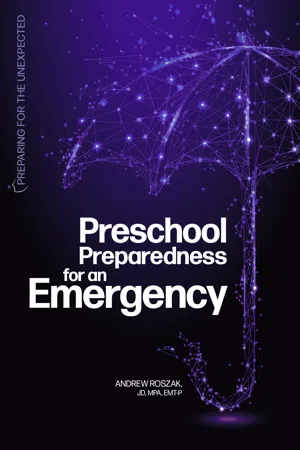
- 108 pages
- English
- ePUB (mobile friendly)
- Available on iOS & Android
Preschool Preparedness for an Emergency
About This Book
Storms, flooding, earthquakes, epidemics, tornadoes, fire. You hope it never happens, but you know you need to be ready. Preschool Preparedness for an Emergency, the second book in the Preparing for the Unexpected Series, will train you for a worst-case scenario. While this may seem like a daunting task, it's easier when you break it down. Emergency-preparedness expert Andrew Roszak will teach you how to: • Reduce potential harm or damage • Develop and test emergency action plans • Empower staff to respond effectively • Satisfy licensing and other regulatory requirements • Act quickly to protect lives and property • Make families more prepared • Develop relationships with local emergency-response organizations • Limit the amount of time your business is closed • Pick up the pieces and return to normal You can't stop a disaster from happening, especially when Mother Nature is the force behind it. But, you can be ready to act when it does.
Frequently asked questions
Information
Responding to
Infectious Disease
Outbreaks and Other Disasters
- Virus: a microscopic organism that may cause disease. Viruses can contain either DNA or RNA and reproduce in living cells. Viruses spread by using living cells to multiply. Examples include the common cold, chicken pox, rabies, herpes, measles, Ebola, HIV, hepatitis, severe acute respiratory syndrome (SARS), and Middle East respiratory syndrome (MERS) (Healthline Media, 2020).
- Communicable or contagious: for our purposes, these words can be used interchangeably. These terms refer to the ability of a disease to be spread or transmitted.
- Social distancing: a public health term used to describe one method of stopping the spread of an infectious disease. The term means maintaining physical distance from others and also avoiding congregate settings. In practice, this means limiting the number of people who are able to gather at any given place or location (Santa Clara County Public Health Department [SCCPHD], n.d.).
- Isolation: the act of separating an individual who is sick from those who are not sick
- Quarantine: separating an individual or group of individuals who may have been exposed to a disease or illness. These individuals are not currently showing any signs or symptoms of being sick. Quarantine is used in cases when we do not know whether a person is infected (SCCPHD, n.d.).
- Endemic: the amount of disease that is normally found in a community. This can be considered the baseline level of disease (CDC, 2012).
- Epidemic: when the amount of disease in a given area rises, often suddenly, above the normal (or endemic) level (CDC, 2012)
- Outbreak: an epidemic in a limited geographic area, such as a neighborhood, city, or county (CDC, 2012)
- Pandemic: an epidemic that has large reach and impact. Normally, pandemics refer to epidemics that have spread to a large number of individuals. This could include several countries or even an entire continent (CDC, 2012).
- Families and staff should be provided with information about the current situation. This should include a summary of the disease and the signs/symptoms of those who are ill. It is also wise to provide families with a list of steps that you are taking to protect children and minimize the spread of the illness.
- Emphasize the importance of staying home when sick. This includes families and staff members alike. If a parent notices her child is experiencing signs or symptoms, then the child should remain at home. Likewise, if a staff member is sick, she should not report to work.
- If the situation warrants daily health screenings, you would require staff and children to undergo a health screening before being admitted into the school or program. The health screener would look for signs/symptoms and may also ask questions concerning potential contact with sick or infected individuals.
- Implement procedures to deal with staff or children who become sick on-site.
- Establish clear criteria on when the sick individual may return to the program. As each disease is different, these criteria will need to be flexible and take into account the specifics of the particular illness or disease. Some programs may require a doctor’s note before granting reentry into the program or school.
Table of contents
- Acknowledgments
- Chapter 1Childhood Preparedness at a Glance
- Chapter 2Understanding the Necessity of Preparedness inChild Care
- Chapter 3Creating anEmergency Plan
- Chapter 4Communication
- Chapter 5 Responding to Infectious DiseaseOutbreaks and Other Disasters
- Chapter 6 Testing and Revising Your Emergency Plan
- Chapter 7 Sample Emergency Plans
- Sample of Checklist to Maintain Accountability of FamilyReunification
- References and Recommended Reading